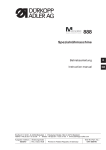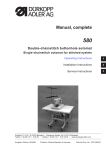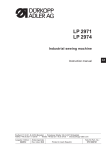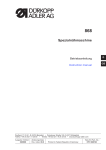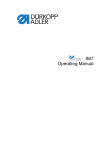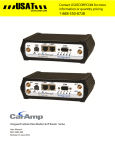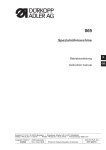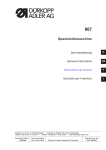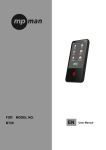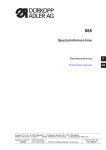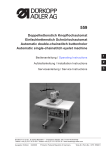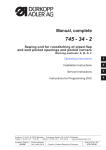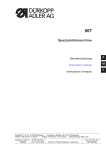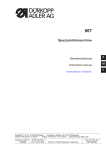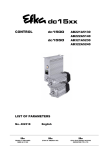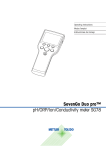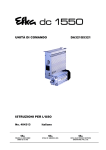Download 888 service
Transcript
888 Service Instructions All rights reserved. Property of Dürkopp Adler AG and protected by copyright. Any reuse of these contents, including extracts, is prohibited without the written approval in advance of Dürkopp Adler AG. Copyright © Dürkopp Adler AG - 2012 Foreword This instruction manual is intended to help the user to become familiar with the machine and take advantage of its application possibilities in accordance with the recommendations. The instruction manual contains important information on how to operate the machine securely, properly and economically. Observation of the instructions eliminates danger, reduces costs for repair and down-times, and increases the reliability and life of the machine. The instruction manual is intended to complement existing national accident prevention and environment protection regulations. The instruction manual must always be available at the machine/sewing unit. The instruction manual must be read and applied by any person that is authorized to work on the machine/sewing unit. This means: – – – Operation, including equipping, troubleshooting during the work cycle, removing of fabric waste, Service (maintenance, inspection, repair) and/or Transport. The user also has to assure that only authorized personnel work on the machine. The user is obliged to check the machine at least once per shift for apparent damages and to immediatly report any changes (including the performance in service), which impair the safety. The user company must ensure that the machine is only operated in perfect working order. Never remove or disable any safety devices. If safety devices need to be removed for equipping, repairing or maintaining, the safety devices must be remounted directly after completion of the maintenance and repair work. Unauthorized modification of the machine rules out liability of the manufacturer for damage resulting from this. Observe all safety and danger recommendations on the machine/unit! The yellow-and-black striped surfaces designate permanend danger areas, eg danger of squashing, cutting, shearing or collision. Besides the recommendations in this instruction manual also observe the general safety and accident prevention regulations! General safety instructions The non-observance of the following safety instructions can cause bodily injuries or damages to the machine. 1. The machine must only be commissioned in full knowledge of the instruction book and operated by persons with appropriate training. 2. Before putting into service also read the safety rules and instructions of the motor supplier. 3. The machine must be used only for the purpose intended. Use of the machine without the safety devices is not permitted. Observe all the relevant safety regulations. 4. When gauge parts are exchanged (e.g. needle, presser foot, needle plate, feed dog and bobbin) when threading, when the workplace is left, and during service work, the machine must be disconnected from the mains by switching off the master switch or disconnecting the mains plug. 5. Daily servicing work must be carried out only by appropriately trained persons. 6. Repairs, conversion and special maintenance work must only be carried out by technicians or persons with appropriate training. 7. For service or repair work on pneumatic systems, disconnect the machine from the compressed air supply system (max. 7-10 bar). Before disconnecting, reduce the pressure of the maintenance unit. Exceptions to this are only adjustments and functions checks made by appropriately trained technicians. 8. Work on the electrical equipment must be carried out only by electricians or appropriately trained persons. 9. Work on parts and systems under electric current is not permitted, except as specified in regulations DIN VDE 0105. 10. Conversion or changes to the machine must be authorized by us and made only in adherence to all safety regulations. 11. For repairs, only replacement parts approved by us must be used. 12. Commissioning of the sewing head is prohibited until such time as the entire sewing unit is found to comply with EC directives. 13. The line cord should be equipped with a country-specific mains plug. This work must be carried out by appropriately trained technicians (see paragraph 8). It is absolutely necessary to respect the safety instructions marked by these signs. Danger of bodily injuries ! Please note also the general safety instructions. Contents Page: Service instructions Class 888 (Edition 05/2012) 1 1.1 1.2 General notes Gauges. . . . . . . . . . . . . . . . . . . . . . . . . . . . . . . . . . . . . . . . . . . . . . . . . . . . . Position of the handwheel . . . . . . . . . . . . . . . . . . . . . . . . . . . . . . . . . . . . . . . . . 2 2.1 2.2 2.3 2.4 2.5 2.6 2.7 2.8 2.9 2.10 Bottom feed Basic setting of the stitch adjustment and the stitch length limitation . Stitch conformity of forward and backward stitch . . . . . . . . . . . . . Setting of levers on the rear feed shaft . . . . . . . . . . . . . . . . . . . Position of the eccentric for the feed movement . . . . . . . . . . . . . . Switching of the feed clutch . . . . . . . . . . . . . . . . . . . . . . . . . . Position of the eccentric for the switching of the feed clutch . . . . . . Checking the switching of the feed clutch . . . . . . . . . . . . . . . . . Setting of the semi stitch length . . . . . . . . . . . . . . . . . . . . . . . Throat plate . . . . . . . . . . . . . . . . . . . . . . . . . . . . . . . . . . . . Slide wheel feeder . . . . . . . . . . . . . . . . . . . . . . . . . . . . . . . . . . . . . . . . . . . . . . . . . . . . . . . . . . . . . . . . . . . . . . . . . . . . . . . . . . . . . . . . . . . . . . . . . . . . . . . . . . . . . . . . . . . . . . . . . . . . . . . . . . . . . . . . . . . . . . . . . . . . . . . . . . . . . . . . . . . . . . . . . . . . 7 8 9 10 11 12 13 14 15 16 3 3.1 3.2 3.3 3.4 3.5 3.6 Upper feed Position of the needle holder with single needle sewing Needle feed . . . . . . . . . . . . . . . . . . . . . . . . . . . Roller foot . . . . . . . . . . . . . . . . . . . . . . . . . . . . Roller foot lifting . . . . . . . . . . . . . . . . . . . . . . . . Variator of the roller foot drive . . . . . . . . . . . . . . . . Fabric holder for twin needle sewing machines . . . . . machines . . . . . . . . . . . . . . . . . . . . . . . . . . . . . . . . . . . . . . . . . . . . . . . . . . . . . . . . . . . . . . . . . . . . . . . . . . . . . . . . . . . . . . . . . . . . . . . . . . . . . . . . . . . . . . . . . . . . . . . . 17 18 20 21 22 23 4 4.1 4.2 4.3 4.4 4.5 4.6 Setting of the needle bar and of the hook Hook height . . . . . . . . . . . . . . . . . . . . . . . . . . . Needle bar height, clearance of the needle towards the Hook tip guard and loop former . . . . . . . . . . . . . . . Bobbin housing release . . . . . . . . . . . . . . . . . . . . Hook lubrication . . . . . . . . . . . . . . . . . . . . . . . . Shuttle plunger ring . . . . . . . . . . . . . . . . . . . . . . . . . . . . . . . hook tip, loop . . . . . . . . . . . . . . . . . . . . . . . . . . . . . . . . . . . . . . . . . stroke . . . . . . . . . . . . . . . . . . . . . . . . . . . . . . . . . . . . . . . . . . . . . . . . . . . . . . . . . . . . . . . . . . . . . . . . . . . 24 25 26 27 28 29 5 5.1 5.2 Thread setting Thread regulator, check spring, bolt for the thread lever mechanism . . . . . . . . . . . . . . . Bobbin winder . . . . . . . . . . . . . . . . . . . . . . . . . . . . . . . . . . . . . . . . . . . . . . . . 30 31 6 6.1 6.2 6.3 6.4 6.5 Thread cutter Thread cutter height, position of the counter knife Starting position of the thread-pulling knife. . . . . Control cam . . . . . . . . . . . . . . . . . . . . . . . . Bobbin thread clamp . . . . . . . . . . . . . . . . . . Position of the throat plate insert . . . . . . . . . . . 32 33 34 35 36 . . . . . . . . . . . . . . . . . . . . . . . . . . . . . . . . . . . . . . . . . . . . . . . . . . . . . . . . . . . . . . . . . . . . . . . . . . . . . . . . . . . . . . . . . . . . . . . . . . . . . . . . . . . . . . . . . . . . . . . . . . . . . . . . . . . . . . . . . . . . . . 5 6 Contents Page: 7 7.1 7.2 7.3 7.4 Material edge trimmer control Switching the edge trimmer on/off . . . . . . . . Height adjustment of the trimming knife . . . . Adjustment of the trimming knife distance from Knife replacement . . . . . . . . . . . . . . . . . . . . . . 37 38 39 40 8 8.1 Machines with disengageable needle bar Setting the guide bar for the needle bar coupling . . . . . . . . . . . . . . . . . . . . . . . . . . . 41 9 9.1 9.2 9.2.1 9.2.2 9.2.3 Electronic control and machine drive Connections PCB . . . . . . . . . . . . . . Direct Drive DAC classic . . . . . . . . . . Important notes concerning electrostatic Replacing the fuse . . . . . . . . . . . . . . Exchanging the PCB . . . . . . . . . . . . 43 44 44 44 45 . . . . . . . . . . . . . . . . . . . . the throat plate . . . . . . . . . . . . . . . . . . . . . . . . . . . . . . . . . . discharges (ESD) . . . . . . . . . . . . . . . . . . . . . . . . . . . . . . . . . . . . . . . . . . . . . . . . . . . . . . . . . . . . . . . . . . . . . . . . . . . . . . . . . . . . . . . . . . . . . . . . . . . . . . . . . . . . . . . . . . . . . . . . . . . . . . . . . . . . . . . . . . . . . . . . . . . . . . . . . . . . . . . . . . . . . . . . . . . . . . . . . . . . . . . . . . . . . . . . . 1 General notes This service manual describes the setting of the special sewing machine class 888. ATTENTION! The operations described in the service instructions must only be executed by qualified staff or correspondingly instructed persons respectively! Caution: Danger of injury ! In case of repair, alteration or maintenance work turn off the main switch and disconnect the machine from the pneumatic supply system. Carry out adjusting operations and functional tests of the running machine only under observation of all safety measures and with utmost caution. The present service instructions describes the setting of the sewing machine in an appropriate sequence. Please observe in this connection that various setting positions are interdependent. Therefore it is absolutely necessary to carry out the settings by following the described order. For all setting operations of parts involved in the stitch formation a new needle without damage has to be inserted. Machine covers that need to be screwed off and on again for checking and adjusting operations are not mentioned in the text. Hint Some of the shafts of the special sewing machine 888 are provided with flat surfaces. This facilitates the setting considerably. With all settings on flat surfaces always screw in the first screw on the flat surface in the sense of rotation . 1.1 Gauges The locking pin required for the machine setting belongs to the serial equipment of the machine. It comes with the accessories and can be kept at hand at the bottom side of the oil pan. 5 1.2 Position of the handwheel Standard checking The handwheel (4) has a graduation scale printed on. Certain settings are effectuated through these handwheel positions. – Turn the handwheel until the index (3) points to the degree mentioned in this manual. – Carry out the described setting. The index (3) should point to the degree “0" when the needle bar is in its upper dead position . 4 1 3 2 – – – – 6 Loosen the screws of the handwheel using an Allen key of 3 mm (1). Turn the needle bar to the upper dead point and set position (2) using the locking pin (Æ 3 mm). Turn the handwheel so that the index (3) points to the degree mark “0”. Tighten the first screw with the key (1), then turn the handwheel to 50° and tighten the second screw with the key (1). 2 Bottom feed 2.1 Basic setting of the stitch regulation and the stitch length limitation Standard checking 1. When setting the stitch length to “0” the stitch regulator gear should have the least clearance possible when the backtack lever is pushed down. 2. The maximum stitch length is to be limited according to the sewing category and the sewing equipment as described in the operating manual. 5 3 6 4 1 2 – – Loosen screw (1) and pull off the setting wheel (2). Turn screw (3) to the right using a 10 mm wrench and test the clearance by pushing the backtack lever down until the stitch regulator gear has no more clearance, so that rule 1 is observed. – – Set the scale ring (4) with the stitch length “0” to the mark (5). Limit the stitch length according to second rule. In order to do so use the threaded pin (6) and screw it into the corresponding bore hole. The bore holes have numbers that correspond to the maximum stitch length. If the maximum stitch length of 7 mm is required unscrew screw (6) for about 2.5 mm. For this length exists another stop. Attach the setting wheel (2) and tighten screw (1). – – Caution: Danger of injury ! Turn the main switch off ! Proceed with the basic setting of stitch adjustment only with the sewing machine switched off. ATTENTION: Danger of breakage ! If the set stitch length is higher than the sewing equipment in use allows, the needle will hit the throat plate insert. 7 2.2 Stitch conformity of forward and backward stitch Standard checking 1. With a rough adjustment of the stitch regulator gear the machine should not feed when the stitch length is set to “0”. 2. With a fine adjustment of the stitch regulator gear the stitch length of the forward and backward stitch may not differ more than half a stitch length. 2 1 – – – – – – 8 5 3 6 4 Set the stitch length to “0”. Loosen screw (1) and turn the eccentric (2) with its slot (3) as shown in the diagram. Fasten it with screw (1). Loosen screw (4) of the clamping lever and turn the setting frame (5) so that the fish plates (6) come parallel. Tighten screw (4). This procedure accomplishes rule 1. Then the stitch length of forward and backward stitches needs to be compared. Sew 10 stitches forward, push the backtack lever and sew 10 stitches backwared. Turn the eccentric (2) in order to accomplish rule 2. Clockwise direction = forward stitch bigger, backward stitch smaller, Counter-clockwise = forward stitches smaller, backward stitches bigger 2.3 Setting of levers on the rear feed shaft Standard checking When setting the stitch length to “0“ the feed clutch should be in the middle section of the operation end positions. 2 4 5 6 1 3 7 – – – – – 8 Set the stitch length to “0“. Loosen screw (1). Loosen screw (2) and pull out the bolt (3). The two screws found underneath on the lever (4) must be fastened with an Allen key of 3 mm so that they sit on the flat surface of the shaft (5), mount the bolt (3) again. Unscrew the screw on the feed clutch (8) and push into the hole the needle (7). Turn the clutch (8) manually until the needle sinks 5 mm into the bore hole. This procedure accomplishes the rule. Tighten screw (1). Caution: Danger of injury ! Turn the main switch off ! Set the basic setting of the levers only with the sewing machine switched off. ATTENTION: Danger of breakage ! If the middle section of the clutch is overstepped it can come to collisions of parts inside the clutch when sewing with high stitch lengths. 9 2.4 Position of the eccentric for the feed movement Standard checking When the index points to the degree mark “0” on the scale of the handwheel, the feed lever (1) should not move when the backtack lever is being pushed. 1 3 – – – 2 Turn the handwheel so that the the index points to the degree mark “0” and arrest it by using the locking pin (see chapter 1). Loosen screws (2) and turn the eccentric (3) for the rough adjustment approximately into the position shown on the photo. Now effectuate the fine adjustment until the position is found where the feed lever (1) does not move when the backtack lever is being pushed down. Fasten the screws on the eccentric (3). Caution: Danger of injury ! Turn the main switch off ! Set the basic setting of the eccentric only with the sewing machine switched off. ATTENTION: Danger of breakage ! Inaccurate settings shorten the machine’s life span. 10 2.5 Switching of the feed clutch Standard checking The clutch is to be switched when the clutch is motionless, that is in the dead points of its oscillating movement. 4 1 – – – – – 5 2 6 3 Loosen screw (1) of the eccentric (2). Turn the eccentric with line (2) against line (3). Loosen the three screws (4) and the adjustment nut (5). Fasten the adjustment nut (5) until it butts (the tightening torque increases stepwise). Push the clutch (6) to the right as far as possible and fasten the screws (4). Check the adjustment. Turn the eccentric manually in counter-direction. The drag of the eccentric intensifies considerably when the two lines form together one line. Caution: Danger of injury ! Turn the main switch off ! Set the basic setting only with the sewing machine switched off. . ATTENTION: Danger of breakage ! Inaccurate settings shorten the machine’s life span. 11 2.6 Position of the eccentric for the switching of the feed clutch Standard checking When the index points to the degree “313" on the scale of the handwheel, the line (1) on the eccentric should form one line with the lower line (2) on the wedge pusher rod. 3 1 2 – Loosen screw (3). – – Set the handwheel to position “313”. Turn the eccentric in the direction of the arrow until line (1) and line (2) form one line. – Turn the eccentric about 2°back and push it along the axis towards the shaft until the middle between the stop positions is reached. Align the lines (1) and (2) again to form one line and fasten screw (3). – Caution: Danger of injury ! Turn the main switch off ! Set the basic setting only with the sewing machine switched off. 12 2.7 Checking the switching of the feed clutch Standard checking The clutch is to be switched when the clutch is motionless, that is in the dead points of its oscillating movement. This can be recognized through the turning direction of the pulley (1) before and after the dead point. B A 1 1 2 3 4 274° 281° 94° 101° B – Set the maximum stitch length. – Turn the handwheel until the index points to degree “274” (s. chart / A) on the scale. Push down the backtack lever and check whether the turning direction (B) of the pulley (1) corresponds to the chart. Do the same for the degree “281”. If the turning directions do not correspond to the chart correct the settings. If the clutch switches before (smaller angle) try this: Loosen the adjustment nut (5) according to chapter 2.5 and perform the mentioned check again until the correct position of the nut is found. When the clutch switches later fasten the adjustment nut (5). – Caution: Danger of injury ! Turn the main switch off ! Proceed with the basic setting only with the sewing machine switched off. ATTENTION: Danger of breakage ! Inaccurate settings shorten the machine’s life span. 13 2.8 Setting of the semi stitch length Hint: This is an optional equipment. Standard checking When a semi stitch is selected by effectuating a push button, the stitch length that is actually sewn should only be 50% of a 7 mm stitch length and only 60%-70% of a 2 mm stitch length. 4 – – – 14 2 3 1 Loosen screw (1). Turn the object (4) by setting the screw (3) with an Allen key of 2.5 mm (2) until the stitch length produced corresponds to the rule. Fasten screw (1). 2.9 Throat plate Standard checking With the standard setting the throat plate insert should be adjusted to the center of the throat plate. 2 3 2 1 – Push the two push buttons (1) and remove the throat plate. – Loosen the screws (2) and aling the throat plate in the center of the cutout. – – Fasten the screws (2) again. Mount the throat plate and check whether it is set in and fixed correctly. Caution: Danger of injury ! Turn the main switch off ! Proceed with the throat plate setting only with the sewing machine switched off. ATTENTION: Danger of breakage ! An incorrectly fixed throat plate causes the destruction of the parts when the machine is started. 15 2.10 Slide wheel feeder Standard checking 1. The height (A) of the wheel feeder above the throat plate must be adjusted according to the thickness and rigidity of the material. 2. Standard height of teeth above the throat plate insert see chart: Needle thickness Nm 70 - 80 90 - 110 120 - 200 Height of the wheel feeder (A) 0,4 - 0,5 0,4 - 0,5 0,6 - 0,8 A 3. Also the tooth pitch must be adapted according to the material that is to be sewn: thin material – fine teeth in order to avoid marks in the leather soft, thick material – thick teeth for sufficient feed traction 4 5 1 16 2 3 – Set the height of the wheel feeder (5) according to rule 2. Loosen screw (2) by using an Allen key (3) and retighten the screw (1). After reaching the desired height first tighten screw (2) and then retighten screw (1) once again. – In order to lower the wheel feeder, loosen screw (1) and then retighten screw (2). Then the sequence is inversed. – When exchanging the wheel (5) take out the throat plate (see chapter 2.9). Push the slide (4) with the wheel feeder (5) upwards. Exchange the wheel feeder according to rule 3 and remount the parts in inversed sequence again. 3. Upper feed 3.1 Position of the needle holder with single needle sewing machines Standard checking The position of the needle holder is to be set in dependance to the needle thickness according to the folllowing chart. Angular position of the needle holder 3 Needle thickness Nm 70 - 110 1 120 - 160 180 - 200 2 5 4 6 – – – – Remove the thread guide (1). Loosen screw (2) and turn the needle bar with the right groove edge (3) to the needle bar axis (in sewing direction) and tighten screw (2). Bring the needle bar to the upper dead center and loosen the screw of the needle holder through the bore (4) by using an Allen key of 2.5 mm (5). Turn the needle holder (6) according to the rule and tighten the screw. 17 3.2 Needle feed Standard checking 1. The needle bar must be set in line with the presser foot bar. 2. The post bed feed is to be set 2.1 with single needle machines, so that the axis of the needle is displaced about A = 0,1 mm to the left of the stitch hole center. 2.2 with twin needle machines, so that the needles are symmetrical to the stitch hole centers. 3. The feed movement of the needle should be set, so that, with maximum stitch lengths, the needle leaves the throat plate close to the backward edge of the stitch hole A B 1 2 – – 18 Loosen screw (1) and set the needle bar to the measure (B) = 31mm as shown in the diagram. This procedure accomplishes rule 1. Set the adjustment rings (2) and tighten the screws (1). 5 3 fig. 1 A 4 fig. 2 fig. 3 6 – – – – Loosen screw (3) and the two screws (4). Displace the post bed feed (5) so that rule 2.1 (A) = 0,1 mm according to fig. 1 or rule 2.2 according to fig. 2 is accomplished. Adjust the throat plate insert to the center as described in chapter 2.9. Set the maximum stitch length as described in chapter 2. Set the needle to the position in which it leaves the throat plate insert. Dismantle the rear cover and loosen screw (6). Set the needle manually to the position shown in fig. 3 and tighten screw (6). 19 3.3 Roller foot Standard checking 1. The location surface on the roller foot holder should be aligned in the right angle to the longitudinal axis of the machine . Between the roller foot and the wheel feeder should be a distance of (A) = 0,03 to 0,16 mm. 2. The position of the roller foot in sewing direction should be set as follows: - for single needle machines (B) = 1,3 to 2,3 mm - for twin needle machines (B) = 0 to 2,3 mm 3. The lateral position of the roller foot should be set so that the lower edge of the roller foot ends with the left-hand edge of the stitch hole (8). 1 6 4 2 8 7 A A 5 3 B – – – 20 Loosen screw (1). Displace the presser foot bar vertically according to rule 1. Insert the Philips screw-driver (2) that is part of the accessories into the hole of the roller foot holder (3) and turn the presser foot bar (4) together with the roller foot holder (3) until the Philips screw-driver comes to a right angle with the longitudinal axis of the machine. Tighten screw (1). Loosen screw (5). Displace the roller foot according to rule 2 and tighten screw (5). Loosen screw (6). Displace the roller foot according to rule 3 with the adjusting screw (7) and tighten screw (6). 3.4 Roller foot lifting Standard checking 1. The lifting of the roller foot via hand lever should be of 5.4 to 5.6 mm. 2. The lifting of the roller foot via electromagnet should be of 11.5 to 12.5 mm. 3. The lifting of the roller foot via knee lever should be of about 0.2 to 0.4 mm higher than the electromagnetic lifting (if existing). 3 1 2 4 3 1 6 7 5 – – – – – Dismount the head cover, upper arm cover and solenoid (if existing) of the presser foot lifting. Loosen screw (1). Bring the hand lever (2) into the depicted position and simultaneously screw in screw (3) until it butts against the lever (4). The lever (2) remains in the depicted position. Put a spacer of 5.6 mm underneath the roller foot and push the lever (5) manually according to the figure above until it stops. Tighten screw (1). This procedure accomplishes rule 1. Remove screw (3) and mount the electromagnet of the presser foot lifting (6). In order to check whether rule 2 is accomplished, engage the magnetic core. If the values are not correct, effectuate an adjustment. Set the lifting of the knee lever according to rule 3 by adjusting screw (3). 21 3.5 Variator of the roller foot drive Standard checking 1. With the correct position of the belt tensioner (1) the distance between the two cords of the V-belt should be (A) = 1 to 2 mm. 2. If the difference between upper and lower feed is set to zero on the setting nut (3), the graduation scale on the nut (4) should point exactly to “O”. 5 4 1 3 2 B A – Loosen screw (2) and position the belt tensioner roller (1) according to rule 1. Tighten screw (2). – – Set the diameter (B) = 34 mm by turning the setting nut (3). Make sure that there is no material displacement between upper and lower feed. Sew two narrow strips of sewing material of about 30 cm together. If the strips after sewing are vaulted upward or downward, this indicates a difference between upper and lower feed. The position of the setting nut (3) must be adjusted accordingly. After reaching the point of “zero difference”, the graduation scale on the nut (4) must be adjusted. Turn the nut (4) until the third line of the scale is on the upper edge of the the nut (3). This marks the zero position. Secure the nut (4) with screw (5). – – 22 3.6 Fabric holder for twin needle sewing machines Standard checking 1. The fabric holder should touch the sewing material without exerting any pressure on it. 2. The fabric holder should be positioned in sewing direction and laterally on the edges of the stitch holes. 4 7 1 2 5 6 3 6 – – – – Insert two pieces of leather of about 1.5 mm thickness underneath the roller foot and set a medium fabric pressure. Loosen screw (1) and displace the holder (2) with the rear fabric holder (3) vertically until it comes to rest without any pressure on the leather. Tighten screw (1), but not too hard. Loosen screw (4) and effectuate the same setting for the front fabric holder (5). Remove the leather, rule 1 is now accomplished. Set the fabric holder according to rule 2: Set the rear fabric holder (3) to the sewing direction by using screw (6) and laterally by turning the holder (2). Set the front fabric holder to the sewing direction and laterally by using screw (7). Tighten all screws. Caution: Danger of injury ! Turn the main switch off. Proceed with the setting only with the sewing machine switched off. 23 4 Setting of the needle bar and of the hook 4.1 Hook height Standard checking The distance A should be 1.55 up to 1.85 mm. A 2 1 3 – Loosen screw (1). – Loosen screws (2), shift the hook at the distance A and tighten the screws (2). Push the ring (3) until its stops at the the hook bottom and tighten screw (1). When replacing the hook, it is not necessary to readjust its setting in height again. – Caution: Danger of injury ! Turn the main switch off. Proceed with the hook setting only with the sewing machine switched off. 24 4.2 Needle bar height, clearance of the needle towards the hook tip, loop stroke Standard checking When the index points to degree “ 203” on the graduation scale of the handwheel (loop stroke 2 mm) and the stitch length is set to “0”, the hook tip should stand in the needle axis, length (A) = 1.5 mm, distance (B) = 0.02 to 0.1 mm. 1 B 4 2 6 7 3 5 8 5 – – – – – – Lock the handwheel in loop stroke position (2 mm) by using the locking pin (5 mm), degree “203”. Loosen screw (2) and turn the hook tip (3) to the needle axis. Loosen screw (4), position the needle bar and needle to the distance measure (A) and tighten screw (4). Loosen the two screws (5) and screw (6) and displace the hook column (7) from off the needle. Slightly tighten screw (5) and bring the hook column to the distance measure (B) by using the screw (8). Tighten screws (5) and (6). Check whether the hook tip (3) is positioned in the range of the needle axis, tighten screw (2). 25 4.3 Hook tip guard and loop former Standard checking A 1. The loop former (1) should be set to have a distance to the needle thinkness of (A) = 0.1 up to 0.2 mm. 2. The guard plate of the hook (3) should prevent a contact between the needle and the hook tip (4). 4 1 3 2 – – – – – – 4 Set the maximum stitch length according to the sewing equipment. Dismount the throat plate. Bend the loop former (1) to have the distance (A) according to rule 1. Position the hook tip (4) on the needle and adjust the setting screw of the guard plate by using an Allen key of 3 mm (2), so that the needle does not touch the hook tip (4). Checking: Exert a light pressure on the needle (see arrow) and turn the hook at the same time. The setting is not incorrect if the guard plate (3) slightly deflects the needle. Caution: Danger of injury ! Turn the main switch off. Proceed with the setting of the hook guard and loop former only with the sewing machine switched off. 26 4.4 Bobbin housing release Standard checking 1. When the locking pin (1) is inserted in the release trigger, the index should point to following the degrees on the graduation scale of the handwheel: - for the right hook column degree “45” to “50” - for the left hook column degree “140” to “145”. 2. The distance measure (A) with max. release should be as follows: - for the needle thickness range Nm 70 to 110 - (A) = 0.5 mm - for the needle thickness range Nm 120 to 200 - (A) = 0.8 mm 4 1 5 2 3 A – Insert the locking pin (1) into the release trigger (2). On the right hook column at the rearside, on the left hook column at the front. Remove the lower plug, loosen screw (3), set the handwheel according to rule 1 and tighten screw (3). – Set the degree “310” on the graduation scale of the handwheel to point to the index, remove the plug, loosen screw (4), turn the bobbin housing release (5) so that the distance measure (A) according to rule 2 is accomplished. Tighten screw (4) and plug the openings again. 27 4.5 Hook lubrication Standard checking A 1. Between the lubricating fitting (2) and the hook should be a distance of (A) = 0.3 mm. 2. The setting screw (3) of the lubrication should proceed 0.5 mm out of the lubricating fitting. 1 – – – 3 2 Loosen screw (1), set the height of the lubricating fitting (2) to the distance measure (A) according to rule 1 and tighten screw (1). This procedure accomplishes rule 1. Screw in screw (3) according to rule 2. In order to throttle the lubrication, screw in deeper the screw (3), but not any further than 0.5 mm below the surface of the lubricating fitting (2). Caution: Danger of injury ! Turn the main switch off. Proceed with the setting of the hook lubrication only with the sewing machine switched off. 28 4.6 Shuttle plunger ring Standard checking With the sewing equipment for light-weight material (needle thickness Nm 70 to 80) a shuttle plunger ring with spur should be used. 1 – – 2 Dismount the shuttle plunger ring (1). Mount the shuttle plunger ring with spur (2) that is part of a complete sewing equipment. Caution: Danger of injury ! Turn the main switch off. Exchange the shuttle plunger ring only with the sewing machine switched off. 29 5 Thread setting 5.1 Thread regulator, check spring, bolt for the thread lever mechanism Standard checking 2 A 1 1. The right edge of the thread regulator (1) should end at figure 2 on the scale. 2. The check spring (5) should be set to the distance measure of (A) = 10 to 12 mm. The spring travel consists of about 30°. 3. The position of the bolt (8) should be set as follows, depending on the needle in use: Needle thickness Nm Bolt position 70-110 B 7 B 8 120-200 C 5 6 4 3 8 7 – – – 30 C Loosen screw (2), push the thread regulator (1) according to rule to end at figure 2, tighten screw (2). Loosen screw (3). Turn the stop sleeve (4) in the direction of the arrow until the check spring (5) comes off the body (6). Turn the stop sleeve (4) against the direction of the arrow until the check spring (5) touches the body (6). Turn both parts (4) and (6) together to reach the distance measure (A). Detain the body (6) and turn the stop sleeve (4) for another 30° against the arrow. Detain the parts (4) and (6), tighten screw (3). Insert a 3 mm Allen key in the holes (7) and loosen the screws. Bring the bolt (8) into the correct position according to rule 3 and tighten screws (7). 5.2 Bobbin winder Standard checking 1. When the bobbin winder is switched off, the distance between bobbin winder wheel and belt pulley should be (A) = 0.8 mm. 2. The winding procedure should stop automatically, when the bobbin is filled up to 0.5 mm underneath the the bobbin edge. A 1 2 – – Turn the belt pulley to the top using the screws (1). Push the toothed belt to the right so that both screws (1) are accessible. Loosen screws (1) and set the distance measure (A) according to rule 1, tighten screws (1). Determine the bobbin filling by adjusting screw (2). Screw in screw (2) for 1 to 2 mm, but a bobbin on the bobbin winder shaft and wind on thread. Check the filling when the winder switches off and adjust the position of screw (2) until rule 2 is fulfilled. 31 6. Thread cutter 6.1 Thread cutter height, position of the counter knife Standard checking 1. The distance measure between the thread-pulling knife (5) and the hook should be (A) = 0.2 mm. 2. The distance measure between the counter knife (6) and the thread-pulling knife (5) should be (B) = 0.3 to 0.5 mm. 3. The knives should have contact at the distance (C) = 1 to 2 mm. 6 C A B 5 5 3 3 4 2 1 – – Loosen screws (1), (2), (3) and push the holder (4) downwards. Slightly tighten screw (2), that sits on the surface of the shaft. – Tighten screw (3) until the distance measure (A) = 0.2 mm is set and thus rule 1 is accomplished. Tighten screw (2) and afterwards also screw (1). Dismount the column protection. – – – – – – – Loosen screws (3) and (4). Set the distance measure (B) = 0.3 to 0.5 mm according to rule 2. Slightly tighten screw (4). Turn the handwheel, so that the index points to degree “270” . Turn the thread-pulling knife (5) manually to set it to the distance measure (C) = 1 to 2 mm and adjust the counter knife (6) accordingly until the knives touch smoothly (without any pressure). Tighten screws (3) and (4) and check whether the knives touch at the distance (C). Caution: Danger of injury ! Turn the main switch off. Proceed with the thread cutter setting only with the sewing machine switched off. Attention! When the pressure of the counter knife is set too high this results in a higher knife wear 32 6.2 Starting position of the thread-pulling knife Standard checking When the roller (1) is in the highest point of the control cam (2) the end of the thread-pulling knife (3) should overrun the blade of the counter knife (4) of 0.5-1 mm. 1 5 2 4 3 6 – – – – – Check whether the control cam (2) butts against the circlip (5). Position the control cam according to the rule. Loosen screw (6). Set the thread-pulling knife (3) according to the rule. Tighten screw (6). Caution: Danger of injury ! Turn the main switch off. Proceed with the thread cutter setting only with the sewing machine switched off. 33 6.3 Control cam Standard checking 1. Between the highest point of the control cam (1) and the roller (2) should be a distance mesure of (A) = 0.05 to 0.1 mm. 2. The threads should be separated when on the handwheel degree “40” to “45” points to the index. 2 A 3 – – – – 1 4 5 Loosen the counter nut, turn screw (3) until the distance (A) = 0.05 to 0.1 mm according to rule 1 is set between the roller (2) and the highest point of the control cam (1). Loosen the two screws (4). Set the handwheel until the index points to degree “40” to “45” on the scale. Set the thread-pulling knife (5) manually so that the blade of the thread-pulling knife overlaps the blade of the counter knife. Push the control cam (1) to the left and at the same time turn it in the turning direction of the machine until roller (2) butts. Tighten the screws (4). Caution: Danger of injury ! Turn the main switch off. Proceed with the control cam setting only with the sewing machine switched off. 34 6 6.4 Bobbin thread clamp Standard checking The clamping effect of the spring (1) should not be set stronger than the strength needed to pull out the bobbin thread of the hook. 1 3 2 – – – Sew and cut the threads. Check with a screw driver (2) as shown in the figure whether the thread is pulled out of the bobbin or out of the clamp (1). Adjust the clamping effect of the spring (1) with screw (3) until the rule is accomplished. Caution: Danger of injury ! Turn the main switch off. Proceed with the clamp spring setting only with the sewing machine switched off. Attention! A wrong setting of the clamp spring can lead to problems at the seam beginning. 35 6.5 Position of the throat plate insert Standard checking When sewing with a short stitch, the throat plate insert should be pushed aside towards the operator in order to avoid a missed stitch at the seam beginning. 2 1 – – – Set the stitch length to 1.5 to 2.5 mm depending on the thread size. Check whether at the seam beginning missed stitches occur. If this is the case, push the throat plate insert (1) into the direction of the arrow until the rear edge of the stitch hole (2) has a distance of 0.2 to 0.3 mm to the needle. Screw the throat plate insert on again. Limit the stitch length to 2.5 mm. The rule of the stitch length limitation is described in chapter 2.1. Caution: Danger of injury ! If the position of the throat plate insert has been altered and the stitch length is not limited to 2.5 mm, the needle will hit the throat plate insert with higher stitch lengths and needle breakage will occur. At the same time the operating personnel will suffer injury. 36 7 Material edge trimmer control 7.1 Switching the edge trimmer on/off 3 5 B 4 2 1 1 A Switch on – Push the knob (1) in the direction of the arrow (A) or pull the handle (2) in the direction of the arrow (B) until the trimming knife moves from its initial position (3) to the trimming position (4). – The edge trimming mechanism is started automatically when switched on, and the trimming knife starts oscillating. While sewing trimming (e.g. a lining) is effectuated simultaneously. – When trimming edges, direct the trimmed material to come underneath the knife collar (5). Switch off – Push the knob (1) downwards. The trimming knife turns from the trimming position (4) to the initial position (3) and the edge trimming mechanism switches off automatically. 37 Height adjustment of the trimming knife A 7.2 1 – – Adjust the trimming knife height with the nut (1). When tightening the nut, the knife shifts upwards, and vice versa. Adjust it in a way that the gap (A) corresponds to the thickness of the material to be trimmed. If the material is thicker in some section (e.g. at sections where two parts of lining are sewn together), the trimming knife height is automatically adjusted to the increased material thickness . Attention! If the trimming knife is set too high, its cut will be of poor quality and will also damage the upper layer of the material. If the trimming knife is set too high, the edge trimming is noisy. 38 7.3 Adjustment of the trimming knife distance to the throat plate A 1 2 – – – – Switch the machine off and switch the edge trimming mechanism on. Loosen the bolt (1) and tighten it slightly (only to set up the gap A). Turn the bolt (2) in clockwise direction, shift the trimming bolt to the left or to the right. Adjust the gap between the knife and the throat plate to approx. (A) = 0.05 mm. Attention! An excessive gap between the knife and throat plate will result in a trimming of poor quality. If the knife touches the throat plate, an unpleasant noise will occur. 39 7.4 Knife replacement 2 1 5 6 3 4 – – – – – Switch the knife off and switch the edge trimming mechanism on. Loosen the bolt (1) and remove the knife (2). Open the cover (3) and turn the eccentric (4) manually until the trimming knife holder (5) is in its front dead center. Insert a new knife and, with its trimming edge, shift it to the needle hole center. The knife should be oscillating in the space behind the needle hole center. Tighten screw (1). Attention! If the knife oscillates in the space in front of the needle hole center, the trimmed material will be poorly trimmed with a small radius in the point where the seam continues in the right angle . 40 8 Machines with disengageable needle bar 8.1 Setting the guide bar for the needle bar coupling 2 1 1 4 3 Caution: Danger of injury ! Turn the main switch off. Proceed with the setting of the guide bar for the needle bar coupling only with the sewing switched off. Set the guide bar (1) in a way that at position zero (both needles engaged) the pivot centre (4) stands exactly above the pin (3). – Loosen the screws (2). – Correct the guide bar’s (1) position accordingly. – Tighten the screws (2). – Check whether the needle bars can be switched correctly. 41 9 Electronic control and machine drive Detailed operating instructions of the positioning drive are enclosed with the sewing machine. A selection of instructions concerning the controlling and adjustments of the drive, accessible to the operator, are included in the operating instructions. A selection of instructions needed for the setting of the drive, provided for the technician, are included in operating instructions. The operating instructions of the positioning drive are enclosed with the sewing machine (see also www.efka.net). 42 9.1 Connections PCB For the sake of completeness, the various connections of the PCB below are explained here. X11 Control Sewing Drive X12 Solenoid Thread Tension X13 Solenoid Additional Thread Tension X14 Solenoid Stroke Adjustment Pneum. X15 Solenoid Sewing Foot Lifting X16 Solenoid Tack X17 Solenoid Switching Stitch Length X18 Solenoid Short Stitch X19 HP-Potentiometer in the Arm (Speedomat) X20 Key Block X21 Light Barrier Seam End X23 Speed Limitation Stitch Length X22 1 +24V 2 Output Thread Cutter 5 Output Needle Cooling 3 Output Flip-flop 3 Adjustable via Parameter 275 6 Output Thread Clamp 9 Output Motor Running / Signal 10 0V 4 Output Sewing Foot Lifting 7 u. 8 +24V For each connection make sure to have one wire connected to the +24V and the other one to the output function. X24 Residual Thread Monitor X25 Oil Level Monitoring X26 Input Machine Run Blockage (Possibility of connecting an external ext. PIN 2/3) X27 Output for max. 50 mA J2 Jumper 2 Closed: bridging the input machine run blockage X26 PIN 2/3 Open: an external “trigger” button must be connected to the X26 PIN 2/3. 43 9.2 9.2.1 Direct Drive DAC classic Important notes concerning electrostatic discharges (ESD) ATTENTION Before effectuating any works on electronic components: Turn off the main switch. Remove the plug from the socket. · · · 9.2.2 Electrostatic discharges can cause damage to PCBs and other components. You can obtain a certain protection by wearing anti-static gloves or wrist-wraps that you can connect for grounding on the mass of any unpainted metal piece of the machine head or on the switch cabinet. Handle the PCBs with utmost caution. They are very sensitive towards electrostatic discharges. Hold the PCBs only at their edges. Put the PCBs after unwrapping or after dismounting with their components upside onto a grounded statically discharged surface. We recommend to use a conductive foam underlay but not the protective cover of the PCB. · Pay attention not to pull the PCB over any surface. – – Exchange the fuse (1) The fuse serves only for the integrated sewing light transformer. Recplacing the fuse Value: 0,63 A T 44 9.2.3 Exchanging the PCB – – – – Remove the connectors. Loosen the screws (1) for the holding plate of the PCB. Replace the PCB (2) and refix it onto the holding plate. Tighten the screws (1) for the holding plate on the PCB. 2 1 – Replug the connectors. Caution ! Make sure that the motor is connected correctly! (see photo) 45 Notes: 46 Subject to design changes - Printed in Germany - © Dürkopp Adler AG - 0791 888651 - 00.0 - EN - 05/2012 DÜRKOPP ADLER AG Potsdamer Str. 190 33719 Bielefeld Germany Phone +49 (0) 521 925 00 E-Mail: [email protected] www.duerkopp-adler.com


















































